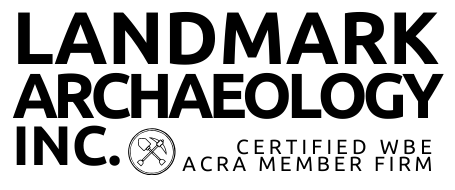Experienced Archaeological Surveys
Newburgh Courthouse African-American Burial Project
Orange County, New York
Landmark Archaeology, Inc. recently completed fieldwork at the Broadway School African-American burial ground in Newburgh, New York. Archaeological investigations were prompted by the unanticipated discovery of three sets of human remains in March 2008 during the renovation of a public school building into a courthouse by the City of Newburgh under the direction of the New York State Office of Courts Administration. Initially treated as a crime scene and investigated by local police, City officials quickly realized that construction had encroached upon what is identified as the “Colored Burying Ground” on an 1869 dated map.
In May 2008, Landmark’s first efforts concentrated on a systematic examination of the location of the initial burial discoveries, about 1.5 meters below-surface grade of a new addition at the north side of the Broadway School. Three additional articulated human burials were identified shortly after initiating fieldwork. The graves were oriented east/west and lying in a supine position. Preservation of the skeletal remains was generally good. No personal items were recovered. Coffin wood was not present, though coffin nails were recovered from each grave.
Based on the identification of the three additional graves and cartographic evidence indicating that the 19th century cemetery extended into other areas of construction, Landmark was retained to systematically examine and disinter all graves within the 0.5-acre project area. Fieldwork was conducted and organized within a sequence of zone excavations that allowed construction activities to proceed uninterrupted throughout the duration of the four-month archaeological investigation.
In total, 106 graves were identified in the project area. Though post field osteological analysis has only begun, field examination of the cemetery’s population identified 19 children, 11 adolescents, 70 adults and six individuals indeterminate in age. The cemetery was organized along north/south rows with only one interment facing west. Personal items buried with individuals were scarce and very few pieces of clothing were recovered. The most common artifacts found in association with the burials were coffin hardware, buttons, buckles, and straight pins. Coins, two of which date 1832 and 1850, were found in several graves. Except for one coffin, substantial pieces of coffin wood were rarely observed. However, based on grave stains and the spatial patterning of coffin nails, most burials were interred in a six-sided “shouldered coffin” that tapered at the head and foot and was widest at the shoulder.
During the onset of the project, the City formed the Courthouse Burial Ground Working Group. Comprised primarily of Newburgh community leaders, the group was instrumental in establishing dialog between the descendant citizens of Newburgh, the City, Landmark, and the New York State Historic Preservation Office in terms of determining an acceptable level of effort and protocol for burial disinterment, post field osteological analysis, and planning a fitting memorial for onsite reinterment. An important aspect of the committee’s work was planning a series of brief ceremonial events that were held immediately prior to burial disinterment by Landmark. The ceremonies involved African, Native American and Christian religious elements and were attended by members of the community, City officials, construction workers, and archaeologists. The ceremonies provided an opportunity to celebrate human life (past and present), reflect on complex ethical issues, and a respectful venue to commemorate the dead.
ArchaeologiSt Professionals
Landmark Archaeology President and Principal Archaeologist Susan Gade, RPA, is directly involved in supervising field projects and artifact analysis, and writing proposals, research designs and reports. She has developed and implemented research designs for all levels of archaeological investigations for prehistoric and historic sites in the northeast and Midwest regions of the United States. Landmark Archaeology co-owner and Principal Archaeologist Derrick J. Marcucci, RPA, assists in administering the company while also conducting and supervising archaeological and historical research projects. He has has extensive experience applying GIS/GPS technology to CRM applications, and is currently is a New York Archaeological Council (NYAC) board member.
Landmark Archaeology
Employment Opportunities
Landmark Archaeology, Inc. is a full service cultural research management firm. Our projects range from Phase I surveys to Phase III data recovery plans in the Midwest and throughout New York and the Northeast. Qualified and highly motivated individuals are encouraged to submit resumes with references for employment consideration with Landmark Archaeology, Inc. Individuals interested in applying for field technician positions should contact us in the early spring and fall. We offer competitive salaries with benefits (health care, paid holidays, paid vacations). Salary is dependent upon professional experience and qualifications. Landmark Archaeology, Inc. is an equal opportunity employer. If you would like to be considered for a position please send a cover letter along with your current resume and references to 6242 Hawes Road, Altamont, NY 12009 or to dmarcucci@landmarkarchaeologyinc.com.
CONTACT US
We’ll get right back to you.

